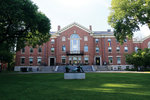
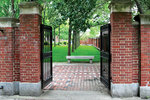
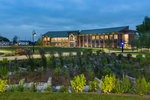
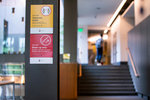
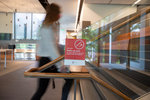
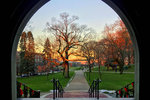


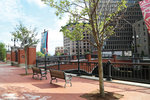
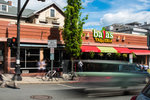
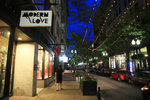
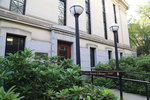
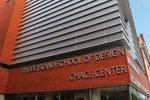
After many months of careful planning – reconfiguring classrooms and dorms, posting notices of health and social distancing protocols, prepping for remote or hybrid learning – Providence universities claim to be ready. But, with a high concentration of people who like to mix and mingle, the only difference between a nursing home and a dorm is that students are young, social, and free to roam. And for a capital that boasts six major colleges and universities, we wait with bated breath to see just what will happen. One thing is for certain, though: Not only will our campuses look different this year, but so will our entire city.
The route to reopening has been long and anything but linear – and likely still changing as you read this. In a recent piece for Slate, Professor of Economics at Brown Emily Oster wrote, “In the big picture, there are four crucial elements: commitment, flexibility, realism, and a focus on staff.” While she was discussing grade-school education, the same principles apply, including a commitment to creating a plan, flexibility to backtrack if necessary, realism in acknowledging there will be COVID-19 cases, and a focus on the staff who are more susceptible than healthy young people. While Providence’s institutions have each taken a slightly varied approach, they are navigating the season ahead the same as we are, with health – of students, faculty, and city residents – at the helm.
For Providence, Johnson & Wales was the first to try reopening, which brought culinary students back into the kitchen mid-summer; this fall, they host first-years, students with internships, and those enrolled in labs requiring in-person instruction. In contrast, Brown University Spokesperson Brian Clark estimates perhaps 500 undergrads to return at first, with an entirely remote curriculum until things are reassessed mid-September, as the University pursues a staggered student arrival due to a recent uptick in Rhode Island cases. Over at Providence College, Steven Maurano, Associate VP of Public Affairs, Government & Community Relations, most recently revealed they plan to bring back nearly 90 percent of its total student population with a mix of in-person, remote, and hybrid classes.
Regardless of numbers at each school, it’s clear a significant number of bodies will soon be arriving on our doorstep. But what is perhaps the most important question remains unanswered: Who exactly is ultimately responsible for monitoring their behavior – the colleges or the Governor?
It begins before students even step foot into the city. Universities require COVID-19 tests before re-entry, plus a 14-day quarantine upon arrival. Messaging focuses on safety and public health, targeted towards faculty, students, parents, and alumni. Brown, for example, has plans for an extensive campaign that involves education, training, and a community mobilization effort to keep college kids accountable for their actions on and off campus. Tests will be administered throughout the year, and isolation beds have been prepared for those who test positive. “We are planning for a maximum of 30 infected students requiring isolation at any given time,” reads the Ivy League’s plan for 2020-2021, plus three to five contacts presumed for each, totaling 180 quarantine/isolation rooms at the ready. These precautions are all in addition to an emergency plan in case of an outbreak, which relies on guidance from the Rhode Island Department of Health and CDC.
“To mitigate the risk of students living together in close proximity, the number of students per room and using shared bathrooms has been reduced,” offers Danielle Stead Mancuso, senior PR specialist at RISD on the specific topic of housing, which is probably the greatest dilemma facing campuses. “The majority of students will live in single-occupancy rooms – to accommodate this change, RISD has expanded its housing inventory by leasing 200 beds at The Edge College Hill apartments.”
RISD isn’t the only school seeking additional housing off-campus; Brown is renting from 257 Thayer Street, River House, 95 Chestnut Street, and Chestnut Commons, all of which are already geared towards students with fully-furnished options and proximity to shuttle stops. For many, this spillover into the community might be cause for concern: With so many students simultaneously living and learning off campus, how will universities ensure and enforce social distancing, face masks, and symptom tracking beyond the spaces within their control? Almost all – JWU, Brown, PC, RISD, and Rhode Island College – have added addendums to their Student Handbooks and codes of conduct, citing the Good Neighbor Policy and potential disciplinary actions. These guidelines are particularly crucial to colleges like PC, which suffered neighborhood and City Council complaints about partying back in May. “We are sensitive to the fact that the area where many of our off-campus students live is in a zip code that has exhibited one of the highest incidences of COVID-19 in the city,” says Maurano. He reassures that most students will be present on-campus, residing in reconfigured dormitories and even unused buildings transformed for temporary housing.
Housing, however, is just one example of how this fall might look different not just for students, but also the community at large. In fact, the greater impact might not be found in those who will be present in the city – but those who won’t.
On Westminster and Thayer Streets, you’ve likely already noticed a change: suspiciously easy parking, crowd-less sidewalks, and perhaps a quiet that seems unnerving when you’re in the heart of a city. It’s a far cry from years past, where you’d be hard pressed to find a space to stand, let alone park, when Providence was brimming with concerts, conventions, WaterFire, tourists, and students – lots of students. But a deadly virus, worldwide shutdown, and three phases later, we’re left wondering what’s in store for a less populous Providence.
“The colleges and universities are such a part of the fabric of the City that to rip it out will really leave a gaping hole,” says Kristen Adamo, President and CEO of the Providence Warwick Convention & Visitors Bureau. Her words might seem hyperbolic, but in many ways they’re true; without homecoming and parents’ weekends, academic conventions, and collegiate sports, Providence’s hospitality and tourism industry is out some big bucks. The schools are also major employers, offers senior VP of Economic Development & Operations Janet Raymond of the Greater Providence Chamber of Commerce; in fact, as of 2019, a third of Brown’s total personnel were Providence residents, most of whom will continue to operate remotely this fall. With a reduced workforce to frequent retailers and restaurants on their lunch break, small businesses are suffering.
While organizations like the PWCVB, InDowncity, Greater Providence Chamber of Commerce, and The Providence Foundation are teaming up to help an imperiled downtown, the solution is a double-edged sword. “It’s tough,” begins Cliff Wood, Executive Director of The Providence Foundation, “because what does success look like? You want people out and about, but you don’t want them out and about too much.”
Thayer Street is a great case study. With students absent, the College Hill neighborhood has been supporting the street more than ever, notes Executive Director Donna Personeus of the Thayer Street District Management Authority. “It’s been a real gift in this madness,” she says. “Having students come back in a controlled manner will possibly be helpful to the businesses,” which she hopes will not only benefit from the careful influx of collegiate consumers, but continue seeing the community shop and dine while the street isn’t overwhelmed. Then, of course, there’s the matter of the degree to which students follow state regulations on masks, social distancing, and gathering.
City Councilman John Goncalves, one of the dynamic forces behind the Providence Coalition of Neighborhood Associations, recently elected representative of Ward 1, and a Brown graduate himself, acknowledges the difficult decisions colleges face with reopening and commends their relentless efforts in finding safe ways to do so. “As this crisis evolves, however, I remain primarily concerned about the impact university students will have on our greater community, especially those living off-campus amid the most vulnerable among us whose transmission of the virus is a matter of life or death,” he says. “I know institutions are undoubtedly worried about this too, so I look forward to the outreach that they do to surrounding neighborhoods and communities as well as hearing more about the COVID-19 protocols and accountability measures they will take to ensure the safety of our greater community.”
At the end of the day, unlike the workforce whose return from remote is more unclear, we know for certain that Providence will have its students back. Albeit at a different capacity, they will be living, working, and playing in Providence. They will be patronizing our retailers and restaurants, strolling our streets, and injecting life back into downtown. The best we can do while we hold our collective breath is embrace (at an appropriate six feet) the fall semester with cautious optimism. After all, as President of Brown University Christina Paxson said in her New York Times April op-ed regarding reopening college campuses: “Our students, and our local economies, depend on it.”
Other items that may interest you





Comments
No comments on this item Please log in to comment by clicking here